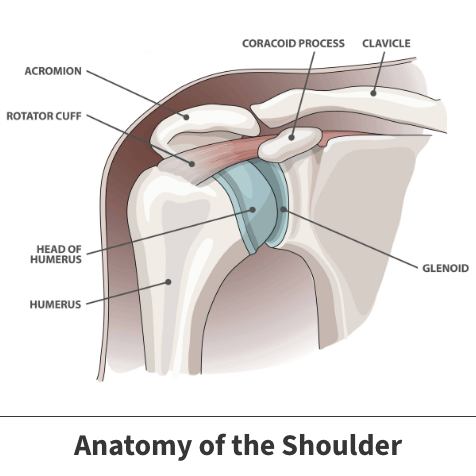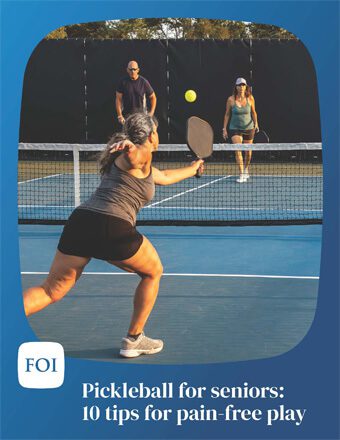Shoulder labrum tear
Glenoid labrum tear
A shoulder labrum tear, or glenoid labrum tear, is an injury where the cartilage that lines and reinforces the shoulder tears, causing pain as well as a variety of other symptoms. This injury can either happen from an impact injury (such as a fall or direct blow to the shoulder) or gradually over time from playing sports that involve lots of shoulder movement. Fortunately, there are both surgical and nonsurgical treatments available to help you fully recover. Surgical procedures are only recommended if your symptoms do not go away after going through nonsurgical treatments, or if your tear is severe.
Anatomy

Your shoulder has three bones: your upper arm bone (humerus), your shoulder blade (scapula), and your collarbone (clavicle). The head of your upper arm bone fits into a rounded socket (known as the glenoid) in your shoulder blade. A combination of muscles and tendons (known as the rotator cuff) keep your arm bone centered in your shoulder socket. The rotator cuff covers the head of your upper arm bone and attaches it to your shoulder blade.
About shoulder labrum tears
A glenoid labrum tear, also known as a shoulder joint tear, is when the cartilage that lines and reinforces the shoulder joint, the glenoid labrum, is torn.
Injuries to the tissue surrounding the shoulder socket can be caused by acute trauma or repetitive shoulder motions. Some examples include falling on an outstretched arm, a direct blow to the shoulder, a sudden pull, or a violent overhead reach. Throwing athletes and weight lifters are also susceptible to tears due to the repetitive shoulder motions that their sport requires.
Tears can be located either above (superior) or below (inferior) the middle of the glenoid socket. The glenoid labrum can also tear partially or entirely. Find out how to prevent glenoid labrum tears and other injuries that can result in pickleball shoulder pain.
Diagnosis
Your Florida Orthopaedic Institute physician will consider your symptoms and take a history of your shoulder pain. After, your physician will do several physical tests to check your range of motion, stability, and pain. Also, your doctor will request X-rays to see if there are any other reasons for your symptoms.
Your physician may also order a CT scan (computed tomography) or MRI scan (magnetic resonance imaging) to help determine if you have torn your glenoid labrum. During these tests, your physician will also be on the lookout for other shoulder injuries, such as a dislocated shoulder, since other injuries typically occur with glenoid labrum tears.
Treatment
There are both surgical and nonsurgical treatments to help heal a glenoid labrum tear. Nonsurgical treatments are typically always tried first, unless your injury is severe or if they are ineffective. Regardless of the type of treatment, both will help you fully recover.
Nonsurgical treatments
Until the final diagnosis is made, your physician may prescribe anti-inflammatory medication and rest to relieve symptoms. Rehabilitation exercises may also be recommended to strengthen your rotator cuff muscles.
Often, nonsurgical methods are effective in relieving symptoms and healing the injured structures. But if these nonsurgical measures are insufficient, your doctor may recommend surgery.
Surgical treatments
Depending upon your injury, your physician may choose a traditional open procedure or an arthroscopic procedure, in which your surgeon uses small incisions and miniature instruments. During either surgery, the doctor will examine the rim and the biceps tendon. If the injury only involves the rim and not the tendon, the shoulder is still stable. If the shoulder is stable, the torn flap is removed and any other problems fixed.
If the tear extends into the biceps tendon or if the tendon is completely detached, the biceps tendon may be considered unstable. If this is the case, then the tendon will need to be repaired or possibly even transferred using absorbable tacks, screws or sutures.
Tears below the middle of the socket are also associated with shoulder instability. During the procedure for this particular tear, the ligament is reattached, and the shoulder is tightened by folding over and “pleating” the tissues.

Pickleball for seniors: 10 tips for pain-free play
Videos
Related specialties
- AC Joint Injuries
- Atraumatic Shoulder Instability
- Bankart Repair
- Bicep Tenodesis
- Broken Collarbone
- Bursitis of the Shoulder (Subacromial Bursitis)
- Calcific Tendinitis of the Shoulder
- Clavicle Fractures
- Dislocated Shoulder
- Fractures of the Shoulder Blade (Scapula)
- Impingement Syndrome of the Shoulder
- Little League Shoulder
- Reverse Total Shoulder Replacement
- Rheumatoid Arthritis (RA) of the Shoulder
- Rotator Cuff Tears
- Shoulder Arthritis
- Shoulder Arthroscopy
- Shoulder Injury: Pain in the Overhead Athlete
- Shoulder Replacement
- Shoulder Separations
- Shoulder Socket Fracture (Glenoid Fracture)
- SLAP Tears & Repairs
- Subacromial Decompression
- Trapezius Strain (Muscle Strain Of The Upper Back)
- Traumatic Shoulder Instability
